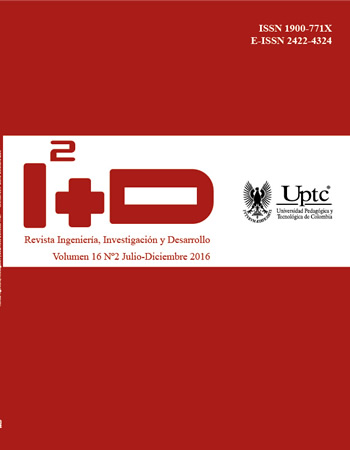Evolución de fases magnéticas presentes en arcillas de Boyacá sometidas a altas temperaturas

Resumen
En este trabajo analizamos muestras de arcilla obtenidas de la región de Tunja – Boyacá, con el objetivo de estudiar el efecto de la temperatura de calentamiento en el color de estos materiales y a la vez como indicativo de la naturaleza y la distribución de sus constituyentes de óxidos de hierro Fe2O3. Estos colores son de relevancia estética en la fabricación de cubiertas y ladrillos en construcción de viviendas. Para evaluar la evolución de las fases, su composición y microestructura en las muestras se utilizó Fluorescencia de rayos X (XRF), Difracción de rayos X (DRX), Espectroscopia Mössbauer (EM) y Microscopia electrónica de barrido (SEM) para muestras sometidas a tratamiento térmico entre (400-1200 ⁰C). Los resultados indican que las propiedades espectrales de las muestras están influenciadas principalmente por la mineralogía del Fe. Se identificaron fases de goetita y hematita en todas las muestras. Los análisis Mössbauer indicaron que con el incremento de la temperatura, la arcilla natural presenta un aumento en la fase de hematita que se refleja también en un incremento del tono rojo del cuerpo de la misma, en contraste con muestras de tono amarillo de la arcilla natural. La formación de hematita y el aumento en su ordenamiento magnético se debe en gran parte a la desaparición de la materia orgánica y la transformación de iones de hierro dispuestos en las fases mineralógicas de la arcilla natural.
Palabras clave
espectroscopia Mössbauer, fases de hierro, hematita, calentamiento, mineralogía
Citas
- Chevalier R., Coey J. M. D. & Bouchez R. 1976. A study of iron in fired clay: Mössbauer effect and magnetic measurements. Journal de Physique: ques. 37(12): suppl., Colloq. 6, pp. C6.861-C6.865.
- Gerstl Z. & Banin A. 1980. Fe2+-Fe3+ transformations in clay and resin ion-exchange systems. Clays and Clay Minerals. 28, pp. 335-345.
- DOI: http://dx.doi.org/10.1346/CCMN.1980.0280503
- Sanyal A. & Mukerji S. J. 1986. Mössbauer study of the effect of iron on the synthesis of sialon from clay. Journal of Materials Science Letters. 5: pp. 787-788. DOI: http://dx.doi.org/10.1007/BF01730092
- Kreimeyer R. (1987). Some notes on the firing colour of clay bricks. Applied Clay Science. 2, pp. 175-183.
- DOI: http://dx.doi.org/10.1016/0169-1317(87)90007-X
- Sherriff L. B., Mc Cammon C., Stirling L. 2002. A Mössbauer study of the color of roman pottery from the leptiminus archaeological site, tunisia. Geoarchaeology. 17(8), pp. 863–874.
- DOI: http://dx.doi.org/10.1002/gea.10044
- Bernal I., Cabezas H. Espitia C. J. Mojica & Quintero J. 2003. Análisis próximo de arcillas para cerámica. Rev. Academia Colombiana de Ciencias. 27(105), pp. 569-578.
- Grygar D. T., Hradilova J., & Bezdicka P. 2003. Clay and iron oxide pigments in the history of painting. Applied Clay Science. 22, pp. 223– 236.
- DOI: http://dx.doi.org/10.1016/S0169-1317(03)00076-0
- Castelein O., Soulestin B., Bonnet J. P. & Blanchart P. 2001. The influence of heating rate on the thermal behaviour and mullite formation from a kaolin raw material. Ceramics International. 27, pp. 517-522.
- DOI: http://dx.doi.org/10.1016/S0272-8842(00)00110-3
- Castelein O., Aldon l., Olivier-fourcade J., Jumas J. C., Bonnet J. P. & Blanchart P. 2002. 57Fe Mössbauer study of iron distribution in a kaolin raw material: influence of the temperature and the heating rate. Journal of the European Ceramic Society. 22(11), pp. 1767–1773.
- Häusler W. 2004. Firing of clays studied by x-ray diffraction and Mössbauer spectroscopy. Hyperfine interactions. 154, pp. 121–141. DOI: http://dx.doi.org/10.1023/B:HYPE.0000032075.92893.57
- Murad E. 2006. Mössbauer spectroscopy of clays and clay minerals. Developments in Clay Science. 1, pp. 755–764.
- DOI: http://dx.doi.org/10.1016/S1572-4352(05)01027-5
- Abdrakhimova E. S. & Abdrakhimov V. Z. 2006. A Mössbauer spectroscopy study of the transformation of iron compounds in clay materials. Russian Journal of Physical Chemistry. 80(7), pp. 1077–1082. DOI: http://dx.doi.org/10.1134/S0036024406070132
- Calogero S., Bertelle M., Antonelli M. & Lazzarini L. 2000. A Mössbauer study of some coloured marbles (Cipollino Mandolato, Rosso Antico and Fior Di Pesco): implications on the nature of their colour. Journal of Cultural Heritage. 1, pp. 429–444.
- DOI: http://dx.doi.org/10.1016/S1296-2074(00)01098-0
- Dionísio A. M., Sequeira A. & Waerenborgh J. C. 2009. Clay minerals and iron oxides-oxyhydroxides as fingerprints of firing effects in a Limestone monument. Applied Clay Science. 42, pp. 629–638.
- DOI: http://dx.doi.org/10.1016/j.clay.2008.05.003
- Valanciene V., Siauciunas R. & Baltusnikaite J. 2010. The influence of mineralogical composition on the colour of clay body. Journal of the European Ceramic Society. 30, pp. 1609–1617. DOI: http://dx.doi.org/10.1016/j.jeurceramsoc.2010.01.017
- Orolínová Z., Mockovciaková A., Zelenák V. & Myndyk M. 2012. Influence of heat treatment on phase transformation of clay–iron oxide composite. Journal of Alloys and Compounds. 511, pp. 63– 69. DOI: http://dx.doi.org/10.1016/j.jallcom.2011.08.023
- Munsell, A. (2016).Recuperado www.munsell.com
- Kamseu E., Leonelli C., Boccaccini D.N., Veronesi P., Miselli P., Pellacani G. & Chinje Melo U. 2007. Characterization of porcelain compositions using two china clays from Cameroon. Ceramics International. 33, pp. 851-857. DOI: http://dx.doi.org/10.1016/j.ceramint.2006.01.025
- Naranjo W., Gaviria S., Manosalva S. 2007. Mineralogía y Geoquímica de Diatomitas (Boyacá, Colombia). Geología Colombiana. 32, pp. 77-88.
- Njoya D., Hajjaji, M., Bacaoui A. & Njopwouo D. 2010. Microstructural characterization and influence of manufacturing parameters on technological properties of vitreous ceramic materials. Materials Characterization. 61(3), pp. 289-295.
- DOI: http://dx.doi.org/10.1016/j.matchar.2009.12.009
- Djangang N.C., Elimbi A., Melo U.C., Lecomte G.L., Nkoumbou C., Soro J., Yvon J., Blanchart P. & Njopwouo, D. 2008. Refractory ceramics from clays of Mayouom and Mvan in Cameroon. Applied Clay Science. 39, pp. 10-18.
- DOI: http://dx.doi.org/10.1016/j.clay.2007.04.006
- Djangang N.C., Kamseu E., Ndikontar K.R. Lecomte Nana G.L., Soro J., Chinje Melo U., Elimbi A., Blanchart P., Njopwouo D. 2011. Sintering behaviour of porous ceramic kaolincorundum composites: phase evolution and densification. Materials Science and Engineering A. 528, pp. 8311-8318.
- DOI: http://dx.doi.org/10.1016/j.msea.2011.07.006